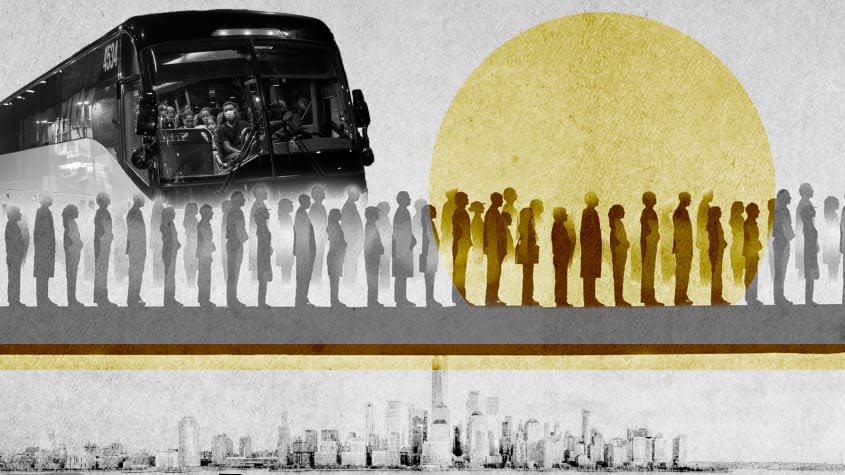The current state of American sanctuary cities

- Oops!Something went wrong.Please try again later.
Immigration continues to be one of the most polarizing issues in the U.S. The ongoing struggle between border states like Texas and Florida and sanctuary cities across the country embodies that tension. Since last year, thousands of people who showed up at the border seeking refuge have been mass relocated to sanctuary cities to protest the Biden administration's immigration policies. Leaders in these cities have begged the federal government to step in as the influx of immigrants has outpaced the resources they have to offer.
Recently the spotlight has been on New York City, where the situation has become so dire Mayor Eric Adams declared there was "no more room." The city's "descent from a place that was managing to keep up, just barely, with a ceaseless flow of asylum seekers to a place that had declared defeat was sudden," The New York Times wrote. "From this moment on, it's downhill," Adams said at a City Hall news conference last week. As the crisis in NYC plays out, people are looking at it as an example of how sanctuary cities handle the influx of asylum seekers.
What are sanctuary cities?
Currently, sanctuary cities or states are communities with policies that limit local law enforcement's cooperation with federal authorities' efforts to deport immigrants. For the past few decades, "U.S. sanctuary city policies have been chiefly about welcoming immigrants whom the federal government has refused to grant humanitarian protection," The Washington Post explained.
In the 1980s, a wave of cities and towns officially declared themselves sanctuary cities and adopted policies restricting cooperation with federal immigration enforcement. Los Angeles was the first city to offer this sanctuary for people fleeing civil wars in El Salvador and Guatemala in 1979, per the Post. Other large cities and college towns followed suit and provided access to local services like schools and healthcare, regardless of immigration status. A clause of the Illegal Immigration Reform and Immigrant Responsibility Act of 1996 "played an outsize role in producing our contemporary landscape of sanctuary cities and anti-immigrant jurisdictions," the Post added. The 287g clause allowed U.S. Immigration and Customs Enforcement (ICE) authorities to deputize local police to help detain and deport illegal immigrants. Many cities have designated themselves as sanctuary cities in response to the clause, making them safe havens for asylum seekers.
How are they handling the influx of asylum seekers?
Since last year, thousands of migrants have been relocated from the border in Texas, Florida, and Arizona to larger sanctuary cities like New York, Denver, Chicago, and Washington D.C. Republican governors have sent busloads and planes full of migrants to these cities to protest the federal government's lax immigration enforcement and the burden being shouldered by border cities. Most relocations have come as a complete surprise for the receiving cities, and they are struggling to keep up with the influx. Mayors from the cities have called on the federal government to help mitigate the crisis, especially leading to the end of Title 42, the pandemic-era asylum regulation that expired in May. With even more migrants projected to enter the country, the cities worried the crisis would put more strain on their resources and budgets.
Before Mayor Adams announced NYC had run out of room, he'd repeatedly asked for government assistance and better communication from the states sending the buses. Migrants had begun to sleep on the streets as placement in the city's shelter system became scarce. The city has spent millions of dollars so far securing housing and providing services to migrants from all over the world. There has been a steady flow of incoming migrants for the past year or so, "nearly doubling the city's homeless population in one huge spasm," the Times reported. Over 100,000 people currently live in shelters throughout the city. The city has tried to find several resolutions to the lack of housing, including taking over entire hotels in Manhattan and building and promptly shutting down temporary shelters.
Denver officials announced in May that they would only allow migrants with formal applications to remain in the U.S. in their emergency shelters. The city has struggled to keep up with the influx of asylum seekers, having spent $20 million sheltering and supporting 12,700 migrants since December, per Axios. The shift could be attributed to a "lack of funding, lack of policy, lack of guidance from our federal government to be able to respond to this crisis appropriately," Victoria Aguilar, a spokeswoman for Denver Human Services, told the Associated Press. Last month the outgoing mayor, Michael Hancock, announced that his administration was no longer moving forward with a $40 million contract with a private company to oversee the city's migrant shelter system, Denverite reported.
Chicago is another sanctuary city feeling the strain for resources for migrants arriving there. At one point, migrants waiting for space in city shelters resorted to sleeping on the floors of local police stations and the airport. The city's shelter system was "over capacity," in May, according to a statement from Brandie Knazze, commissioner of the Chicago Department of Family and Support Services, to city officials. "Make no mistake, we are in a surge, and things have yet to peak," he added. While the migrants staying in police stations have since been relocated to temporary shelters, Chicago officials continue to pressure the federal government to mitigate the ongoing crisis.

